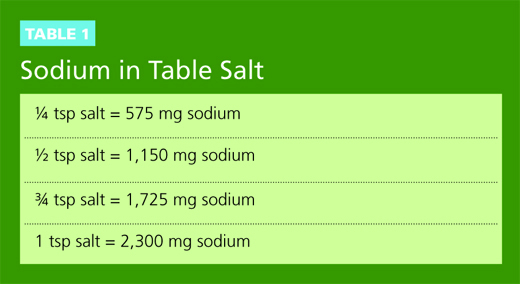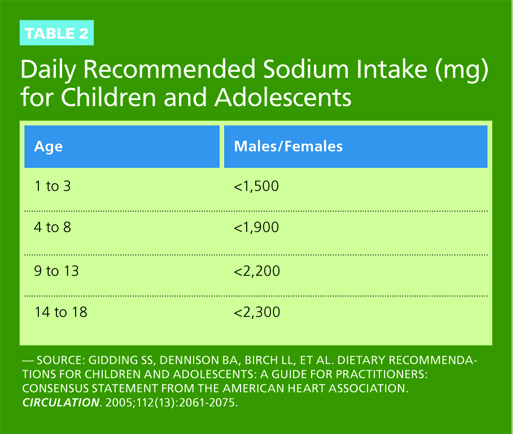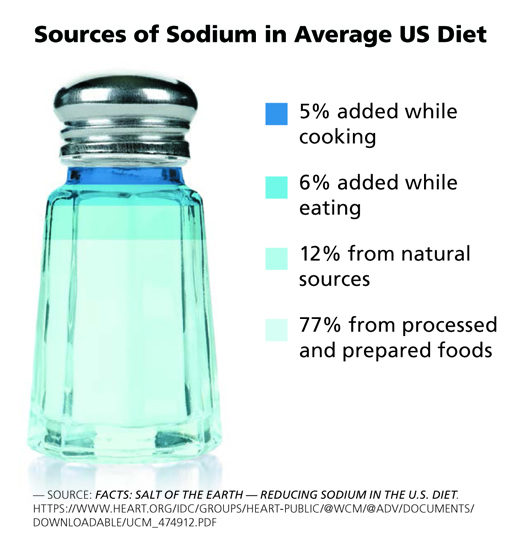Today’s Dietitian
Vol. 19, No. 2, P. 22
Are the threats of high sodium intake to cardiovascular health just as alarming as in adults?
When it comes to sodium intake in adults, the general consensus is that high consumption will increase risk of hypertension and stroke and reduced consumption will lower that risk. Decreasing sodium intake to lower heart disease risk is a recommendation promoted by the American Heart Association, the 2015–2020 US Dietary Guidelines for Americans, and the World Health Organization, among others.1-3
But what about children? Does sodium pose the same risk for children and adolescents as it does for adults? Although there’s far less research on children than on adults, some observational studies have shown an association between high sodium intake and elevated blood pressure in children. However, sodium reduction in these trials often was substantial and unlikely to be applicable to real-life situations, where only modest reductions are likely to be maintained over the long term. Studies have found that sodium reduction in children and adolescents is associated with small reductions in either systolic or diastolic blood pressure in the range of 1 to 3 mm Hg.4 Still, other studies have found no blood pressure reduction with sodium restriction in children.5
An Essential Nutrient
Table salt (sodium chloride) is composed of 40% sodium and 60% chloride. About 90% of sodium intake in the United States comes from sodium chloride. While discussions about sodium are almost exclusively about how to reduce intake, it’s important to remember that sodium is an essential nutrient for both children and adults, working to maintain an adequate volume in the circulatory system and transporting molecules across cell membranes. Hormones and the sympathetic nervous system allow the body to adapt to a wide range of dietary sodium levels and maintain plasma sodium levels within a normal range. Approximately 98% of dietary sodium is absorbed in the intestine, and excess sodium is excreted mainly by the kidneys, while some loss occurs in sweat. In healthy people, urinary sodium excretion roughly equals intake.6 However, as people age or develop kidney disease, the kidneys’ ability to rid the body of excess sodium diminishes. This can result in fluid retention, increased stress on the cardiovascular system, and, ultimately, hypertension.
While most Americans, young and old alike, consume too much sodium, not getting enough also may have dire consequences. Excessive fluid intake, for example, has been shown to cause hyponatremia, during which sodium in the bloodstream is diluted to dangerously low concentrations. It can happen in athletes who consume large amounts of water over a short period of time and can result in seizures, coma, brain damage, and even death. While that’s an extreme example, it does highlight the important role sodium plays in health as well as disease.

Sodium Recommendations
It has been estimated that if Americans dropped to an average intake of 1,500 mg sodium per day, it could result in a 25.6% decrease in blood pressure and an estimated $26.23 billion in health care coverage savings.7 To put 1,500 mg per day into perspective for children, a single kid’s meal at a fast food restaurant could exceed that amount. A recent study published in the Journal of the Academy of Nutrition and Dietetics found that children’s and adolescents’ sodium intakes are incredibly high—almost 90% of children aged 6 to 18 in the United States consume diets that contain far more than current recommended intakes.8 For all children in this age range, the average intake was 3,255 mg per day. The highest intake was among adolescents aged 14 to 18 at 3,565 mg per day. That’s important, as the Centers for Disease Control and Prevention (CDC) has found that one in six children aged 8 to 17 already has above-normal blood pressure.9 “It’s concerning how much sodium American kids continue to consume,” says lead study author Zerleen Quader, MPH, sodium data analyst at IHRC, Inc, and Oak Ridge Institute for Science and Education research fellow in the division for heart disease and stroke prevention at the CDC in Atlanta.
Several studies have found that high sodium intakes in childhood, like those found in the study, can lead to prehypertension/hypertension that can carry over to full-blown hypertension in adulthood.10,11 The association between sodium intake and hypertension appears to be stronger among children who are overweight or obese,11 and the sodium they’re consuming is linked to foods that pose an additional risk of obesity such as sugar-sweetened beverages.12 In addition, some research suggests that high salt intake by itself is associated with obesity. A recent study found that a 1,000-mg boost in sodium intake was associated with a 28% increase in childhood obesity, and is partially linked with greater consumption of sugar-sweetened beverages.13 However, there’s increasing evidence that there may be a direct link among salt intake, inflammation, and obesity that’s independent of energy intake, including sugar-sweetened beverages.14,15 Higher salt intakes may result in greater deposition of fat, suggesting that salt alters body fat metabolism.13
Low-sodium eating patterns such as the DASH (Dietary Approaches to Stop Hypertension) diet have been shown to be effective in adults for lowering blood pressure. The diet, which limits sodium intake to about 2,300 mg per day, includes plenty of whole grains, fruits, vegetables, and low-fat dairy products, as well as some fish, poultry, and legumes, and encourages a small amount of nuts and seeds a few times per week. While there are no clinical studies to examine the effects of the DASH diet in children and adolescents, a recent study in The Journal of Pediatrics found that among children aged 6 to 18, the incidence of hypertension decreased among those who adhered most closely to a DASH-style diet.16
“I think sodium guidelines should apply to children,” says Anne Elizabeth Cudoff, RD, LD, FAND, a retail dietitian at Hy-Vee, Inc, a chain of 240 supermarkets located throughout the Midwest. “As adolescents, they become accustomed to the taste of sodium in food. If higher amounts of sodium are consumed as children, the same flavor will be sought after as adults.”
Children are harder to study than adults because prospective trials require many years of follow-up as they grow into adults, when differences in cardiovascular outcomes could be detected.12 There’s also evidence that children may have varying degrees of sodium sensitivity, ie, some may experience increases in blood pressure with high sodium intakes, while others don’t. Sensitivity in children may be a function of age, birth weight, prematurity, or body weight.11,17 Children who are born prematurely may have differences in kidney function that predispose them to sodium sensitivity. While sodium recommendations for children and adolescents have been issued, based on the evidence available, ideal sodium intakes in children and adolescents have yet to be defined.12

Sodium Stats
The results of the recent study published in the Journal of the Academy of Nutrition and Dietetics provide insight into the sodium intake of school-aged children and where that sodium comes from. Intakes were assessed using 2011–2012 data from the National Health and Nutrition Examination Survey. The current recommended intake for school-aged children ranges from 1,900 mg to 2,300 mg per day, depending on age. The following are a few of the most revealing sodium statistics:
• Almost 90% of the children surveyed exceeded the upper level of sodium recommended for their age group.
• The average sodium intake was 3,256 mg per day, not including any salt added at the table.
• Average sodium intake among US high school-aged children was about 400 to 500 mg higher than younger school-aged children and was comparable to US adults.
• Only 10 types of foods made up almost 50% of kids’ sodium intake, including pizza, Mexican mixed dishes, sandwiches (including burgers), breads, cold cuts, soups, savory snacks, cheese, plain milk, and poultry.
• Sodium was consumed throughout the day—39% of sodium was consumed at dinner, 31% at lunch, 16% from snacks, and 14% at breakfast.
• Sodium intakes were highest for teens aged 14 to 18.
• Girls had significantly lower daily sodium intakes than boys.
• There were no significant differences in sodium intakes based on race/ethnic group, household income, or child weight status.
• Foods obtained from stores contributed 58% of sodium intake, fast food/pizza restaurants contributed 16%, and school cafeterias contributed 10%.
• Non-Hispanic Asian children had the lowest calorie intakes but the highest sodium intakes.

Making Sense of Recommendations for Kids
These study findings are alarming, making it especially important to reduce sodium consumption among children because taste preferences formed in childhood can influence food choices in adulthood.17,18 The researchers involved in the Academy of Nutrition and Dietetics’ study agree, indicating that a decrease in sodium content of commonly consumed commercially processed, store, school, and restaurant foods could result in substantial reductions in excess sodium intake across the US food supply, rather than in a single type of food or venue. Quader says that because the majority of sodium comes from processed and restaurant foods, lowering sodium content across the food supply would lead to significant reductions in sodium intake, allowing children to meet dietary guidelines for all food groups, including dairy, while still maintaining recommended sodium levels. “You can add salt to your meal, but can’t take out sodium that’s already included in food products and meals,” Quader adds.
Cundiff recommends reading the labels of anything that comes in a bag, box, or jar. “Look at the portion size and how much sodium is in the product. I always recommend looking for products that contain fewer than 140 to 200 mg of sodium per serving and to aim for having only one product at each meal that comes from a bag, box, or jar.”
More insights into sodium intakes, hypertension, and children will come from a systematic review and meta-analysis that Swiss and Canadian researchers currently are conducting. The research is designed specifically to look at the association between sodium intakes and blood pressure in children and adolescents and determine whether and how much the association varies according to age and body weight.5
— Densie Webb, PhD, RD, is a freelance writer, editor, and industry consultant based in Austin, Texas.
References
1. US Department of Health & Human Services. Dietary Guidelines for Americans 2015–2020: Eighth Edition. http://health.gov/dietaryguidelines/2015/guidelines/. Published January 7, 2016.
2. Sodium and your health. American Heart Association website. https://sodiumbreakup.heart.org/sodium_and_your_health. Accessed December 1, 2016.
3. Reducing sodium intake to control blood pressure in children. World Health Organization website. http://www.who.int/elena/titles/sodium_bp_children/en
4. National High Blood Pressure Education Program Working Group on High Blood Pressure in Children and Adolescents. The fourth report on the diagnosis, evaluation, and treatment of high blood pressure in children and adolescents. Pediatrics. 2004;114(2):555-576.
5. Leyvraz M, Taffe P, Chatelan A, et al. Sodium intake and blood pressure in children and adolescents: protocol for a systematic review and meta-analysis. BMJ Open. 2016;6:e012518.
6. Doyle ME. Sodium reduction and its effect on food safety, food quality, and human health. UWFRI Briefings 2015. https://fri.wisc.edu/files/Briefs_File/2015-07-15_0917_FRI_Brief_Sodium_Reduction_11_08.pdf. Published November 2008. Accessed December 8, 2016.
7. Mozaffarian D, Benjamin EJ, Go AS, et al. Heart disease and stroke statistics—2015 update: a report from the American Heart Association. Circulation. 2015;131(4):e29-e322.
8. Quader ZS, Gillespie C, Sliwa S, et al. Sodium intake among US school-aged children: National Health and Nutrition Examination Survey, 2011–2012. J Acad Nutr Diet. 2017;117(1):39-47.
9. Reducing sodium in children’s diets. Centers for Disease Control and Prevention website. http://www.cdc.gov/vitalsigns/children-sodium/index.html. Updated September 9, 2014.
10. Aburto NJ, Ziolkovska A, Hooper L, Elliott P, Cappuccio FP, Meerpohl JJ. Effect of low sodium intake on health: systematic review and meta-analyses. BMJ. 2013;346:f1326.
11. Yang Q, Zhang Z, Kuklina EV, et al. Sodium intake and blood pressure among US children and adolescents. Pediatrics. 2012;130(4):611-619.
12. Juncos LI. Salt intake in childhood and adolescence. Hypertension. 2014;63(5):911-912.
13. Ma Y, He FJ, MacGregor GA. High salt intake: independent risk factor for obesity? Hypertension. 2015;66(4):843-849.
14. Zhu H, Pollock NK, Kotak I, et al. Dietary sodium, adiposity and inflammation in healthy adolescents. Pediatrics. 2014;133(3):e635-e642.
15. Libuda L, Kersting M, Alexy U. Consumption of dietary salt measured by urinary sodium excretion and its association with body weight status in healthy children and adolescents. Public Health Nutr. 2012;15(3):433-441.
16. Asghari G, Yuzbashian E, Mirmiran P, Hooshmand F, Najafi R, Azizi F. Dietary Approaches to Stop Hypertension (DASH) dietary pattern is associated with reduced incidence of metabolic syndrome in children and adolescents. J Pediatr. 2016;174:178-184.e1.
17. Simonetti GD, Raio L, Surbek D, Nelle M, Frey FJ, Mohaupt MG. Salt sensitivity of children with low birth weight. Hypertension. 2008;52(4):625-630.
18. Mennella JA. Ontogeny of taste preferences: basic biology and implications for health. Am J Clin Nutr. 2014;99(3):704S-711S.


